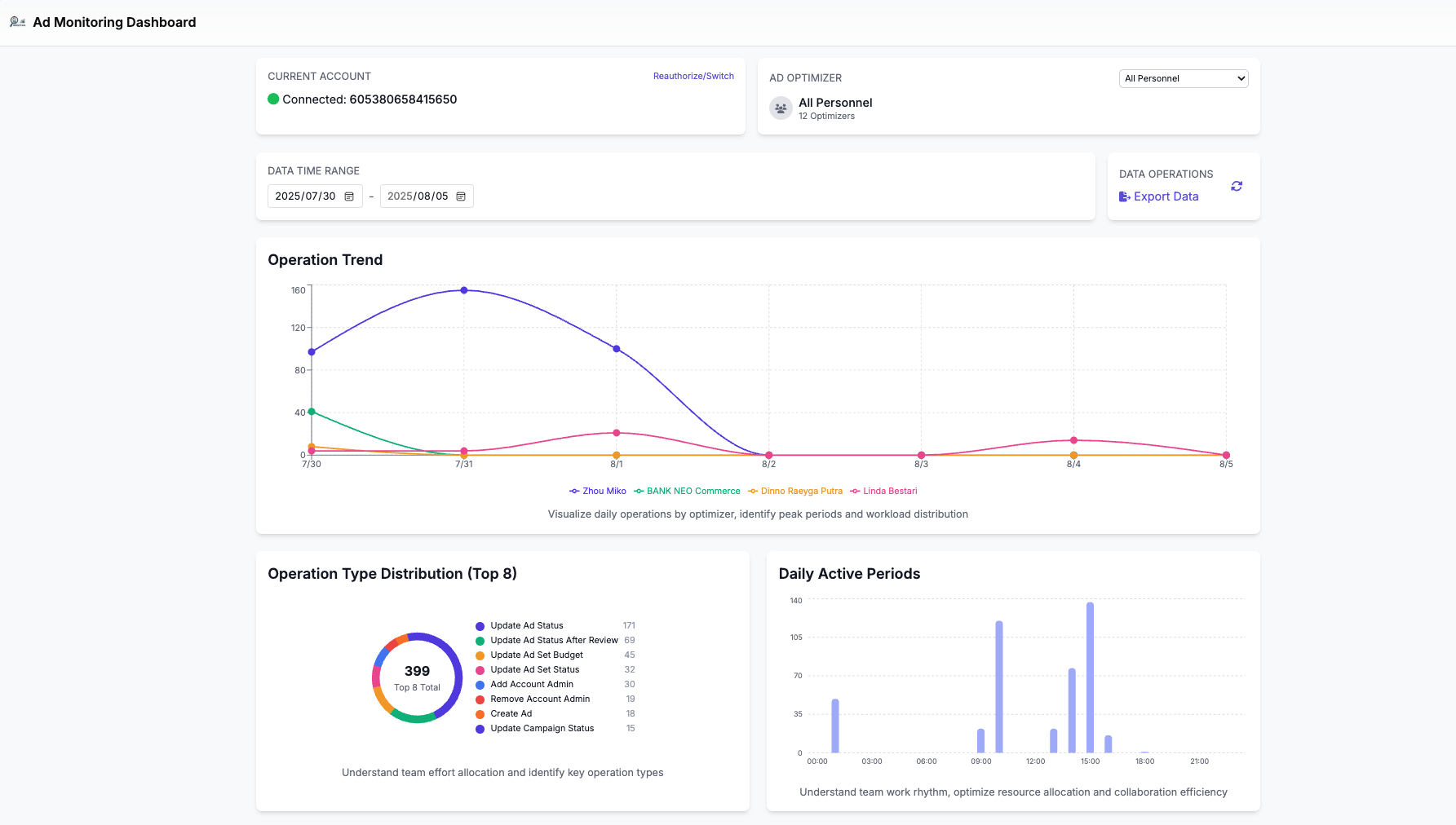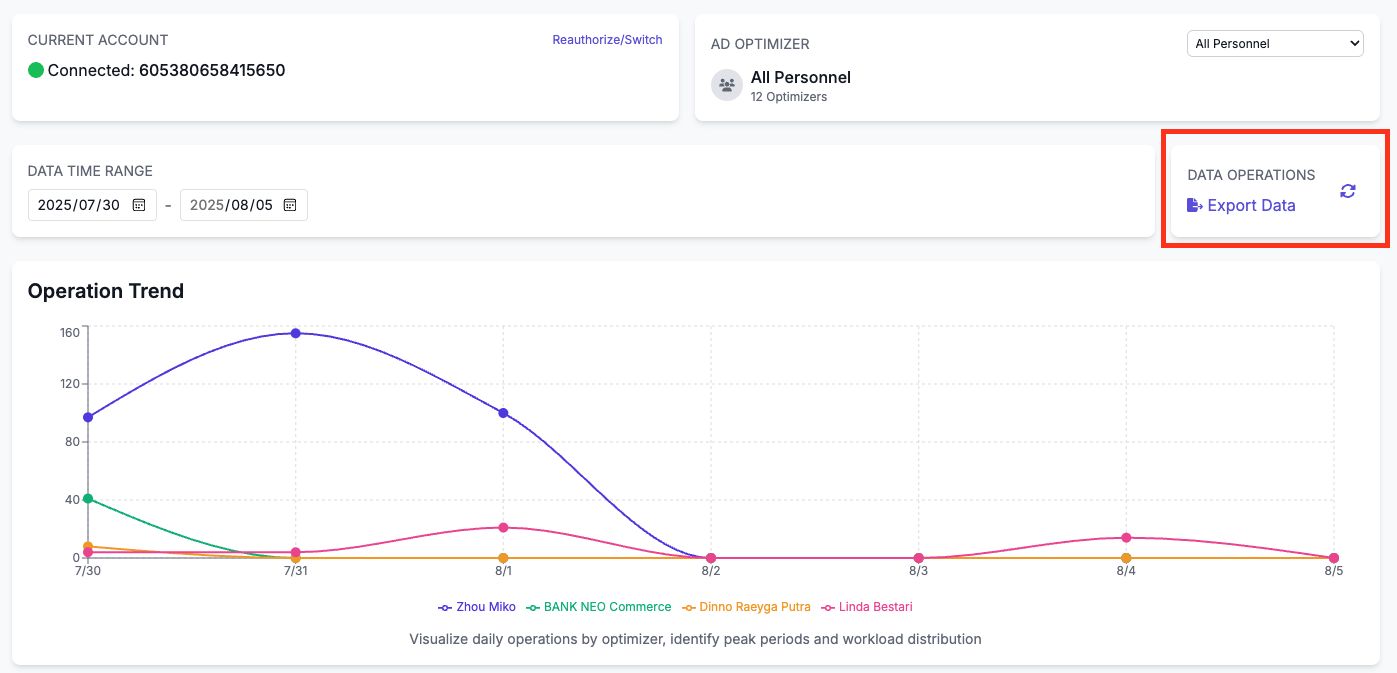A Comprehensive Guide to Improving Ad Operations Efficiency in 2025
Discover 5 actionable steps to improve ad operations efficiency. This guide covers workflow streamlining, team productivity tools, and data analysis for 2025.

A Guide to Improving Ad Operations Efficiency in 2025
In the world of digital advertising, speed and accuracy are everything. As teams manage more accounts, campaigns, and creatives, the risk of manual errors, miscommunication, and wasted budget grows. Simply working harder isn't the answer. The real challenge is improving your team's ad operations efficiency. This guide offers a complete roadmap to help you diagnose bottlenecks, leverage the right data, and implement a smarter workflow for your team in 2025.
The Foundation: Why You Need to Track Every Action
Before you can optimize, you need visibility. Without a clear record of who did what, when, and why, your team is flying blind. Relying on spreadsheets or chat messages for tracking is a recipe for disaster. True efficiency begins with a transparent system that captures every significant action across your ad accounts.
This includes comprehensive monitoring of all critical operations, such as:
- Ad Modifications: Changes to titles, copy, or creatives.
- Budget Adjustments: Daily or lifetime budget increases and decreases.
- Audience Targeting: Tweaks to location, demographic, or interest-based targeting.
An operation activity timeline provides a clear, chronological log of every change. It eliminates guesswork, making it simple to trace the root cause of performance shifts and foster a culture of transparency and shared ownership.

How to Streamline Ad Operations Workflow with Data
Once you have a steady stream of operational data, the next step is to use it to refine your processes. The goal is to move from reactive problem-solving to proactive workflow optimization. Visualizing data is the fastest way to spot patterns and opportunities.
Analyze Operation Trends and Workload Distribution
How is your team's effort really allocated? Are they spending most of their time on budget adjustments or creative swaps? Understanding this is key to balancing workloads and identifying areas for automation. By visualizing daily operations and the distribution of operation types, managers can instantly see:
- Peak Periods: Identify the busiest times of day or week to better manage resources.
- Effort Allocation: See which operation types dominate team activity to align tasks with strategic priorities.
- Team Rhythm: Understand the natural work cycles of your team to optimize collaboration.

Monitor Team and Optimizer Performance
To improve ad operations efficiency, you must understand the performance of individual team members (or "optimizers"). This isn't about micromanagement; it's about empowerment. Tracking operational efficiency across different optimizers allows you to visually compare workloads and contributions. This data helps balance workloads, identify operational patterns to guide training needs, and ensure work is distributed fairly.
Essential Ad Operations Team Productivity Tools & Features
The right technology can be a game-changer. When evaluating tools to support your team, look for features designed specifically to eliminate tedious steps and streamline collaboration.
Centralized Multi-Account Management
For agencies or teams managing multiple brands, switching between different ad accounts is a major time sink and a source of potential errors. A platform that offers quick, seamless switching between accounts from a single interface is a must-have. It centralizes monitoring and dramatically improves management efficiency.
Real-Time Data Synchronization
In a landscape where ad performance can shift dramatically in just a few hours, working with stale data is a critical risk. Ensure your tracking system synchronizes data in real-time. This keeps you constantly aware of your team's latest operations, allowing for timely strategy adjustments and a more agile response to performance changes.
Flexible Time Range Selection
Analyze performance trends over any period. Whether you need a daily snapshot or a quarterly overview, flexible date selection allows you to identify long-term patterns and seasonality, supporting smarter strategic planning.
Multi-Dimensional Data Filtering
The ability to quickly sift through raw data is a superpower. Modern ad operations team productivity tools offer powerful filtering that lets you isolate the information you need. By filtering operations by a specific team member, operation type, or a custom time period, you can turn a mountain of data into actionable insights and answer specific questions in seconds, not hours.
Flexible Data Exporting and Reporting
No single tool does everything. The ability to flexibly export activity data, statistics, and trends is crucial for deeper analysis and stakeholder reporting. Look for tools that support multiple export formats, making it easy to pull data into your preferred business intelligence or spreadsheet software for custom analysis and presentations.

Putting It All Together: A 5-Step Action Plan to Improve Ad Operations Efficiency
Ready to get started? Here is a simple, actionable plan to transform your team's productivity.
- Implement a Centralized Tracking System: Your first move is to adopt a tool that automatically logs all ad account operations. This is the bedrock of your entire efficiency strategy.
- Establish Baselines and KPIs: Use your new data to understand your current state. Set clear key performance indicators (KPIs) for operational activity, not just campaign results.
- Conduct Regular Workflow Audits: Use visual dashboards to review workload distribution and operation trends on a weekly or bi-weekly basis. Identify and address bottlenecks.
- Empower Your Team with Self-Service Analytics: Give your team members access to the data. Seeing the direct impact of their actions naturally fosters engagement and proactivity.
- Foster a Culture of Continuous Improvement: Efficiency isn't a one-time fix. Weave data-driven operational reviews into the fabric of your team's culture to constantly refine and streamline your ad operations workflow.
Conclusion
Boosting ad operations efficiency is no longer a luxury—it's a competitive necessity. By moving away from manual tracking and embracing a transparent, data-driven approach, you can unlock significant gains in productivity. The key is threefold: first, establish complete visibility into your team's actions. Second, use data to understand and refine your workflows. And finally, equip your team with the tools they need to work smarter, not just harder. The result is not just a more efficient team, but better campaign performance, reduced costs, and a stronger bottom line.


